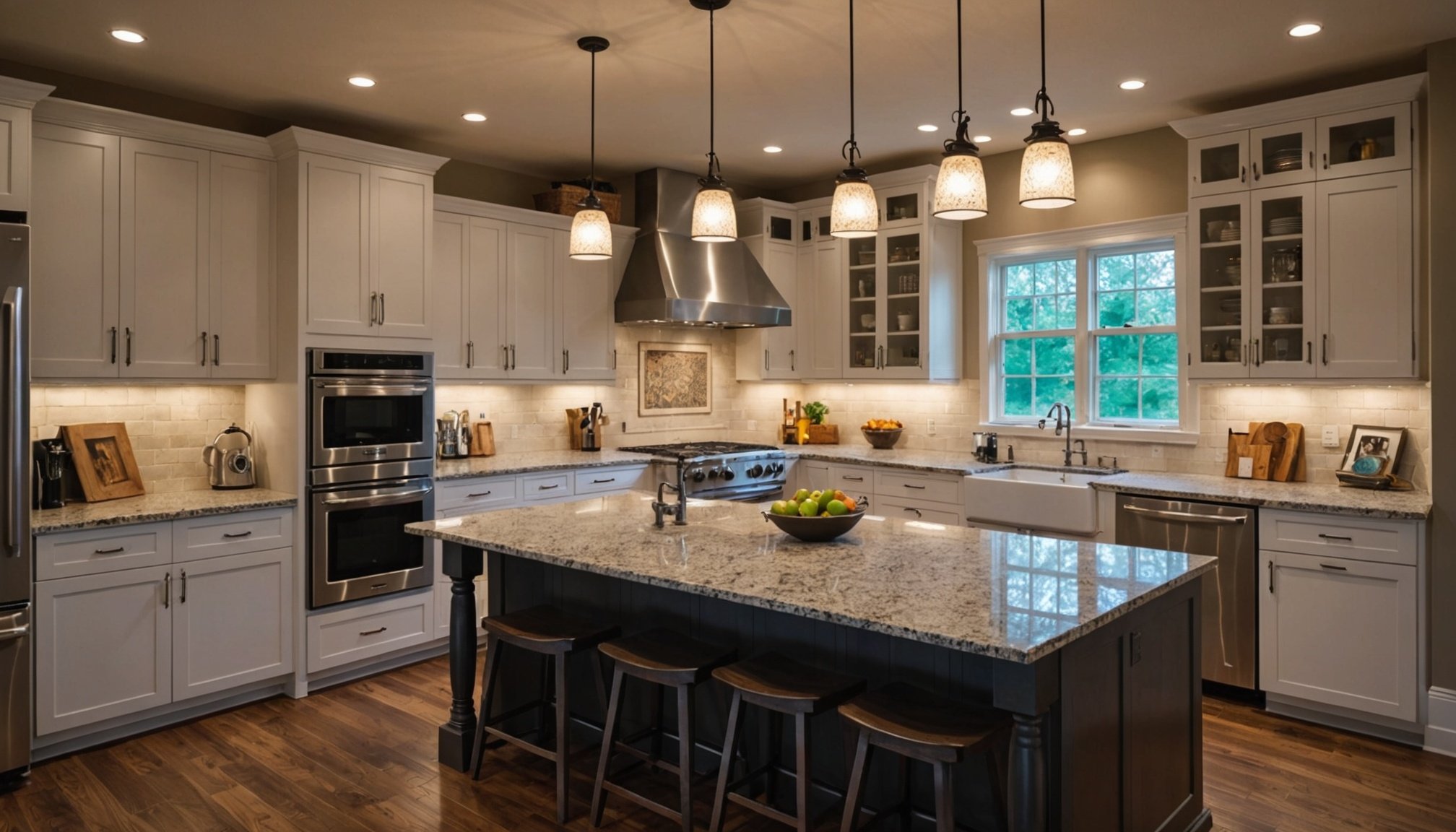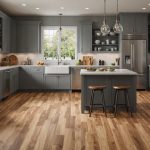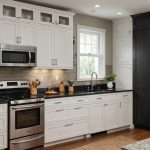Understanding the Importance of Kitchen Lighting
Lighting plays a crucial role in crafting a welcoming kitchen environment. It impacts not only the ambiance but also the functionality and aesthetics of the space. With well-planned kitchen lighting, you can create an inviting atmosphere that enhances social gatherings and culinary experiences.
Glare is one of the factors that can adversely affect kitchen functionality and aesthetics. It occurs when the light source is too intense, causing discomfort or hindering visual tasks. Reducing glare ensures that tasks such as chopping or reading recipes can be completed efficiently, and it enhances the kitchen’s visual appeal by avoiding harsh light contrasts.
Also to discover : The Ultimate Guide to Choosing the Ideal Kitchen Sink Size for Your Family’s Needs
In designing kitchen lighting, understanding light levels and temperatures is essential. The overall light level should be bright enough to illuminate work areas while creating a cozy ambiance. Different light temperatures, measured in Kelvin, affect the space’s mood; warmer temperatures provide a soft, inviting glow, while cooler temperatures offer a crisp, modern feel.
By balancing ambiance and functionality, kitchen lighting can transform your culinary space into a more efficient and attractive area, optimising both everyday use and special occasions. Choosing the right combination of these elements leads to both a practical and aesthetically pleasing kitchen environment.
Topic to read : Ultimate kitchen wellness: your comprehensive guide to effortlessly installing a water filtration system
Choosing the Right Lighting Fixtures
Choosing the correct lighting fixtures involves understanding the types available and their strategic placement to transform your kitchen into an efficient and welcoming space.
Different Types of Kitchen Lighting
Kitchens benefit significantly from a combination of various types of lights. Ceiling lights, such as chandeliers or pendants, provide general illumination. Under-cabinet lights are perfect for brightening workspaces along countertops. Recessed lights, meanwhile, offer a sleek solution for ambient lighting, reducing shadows and highlighting key kitchen areas. Each lighting fixture has a unique role and must be chosen according to specific needs and kitchen layout.
The Importance of Layered Lighting
Layered lighting comprises three essential components: ambient, task, and accent lighting. Ambient lighting ensures the kitchen is well-lit overall, often set by ceiling fixtures like recessed or flush-mount lights. Task lighting, meanwhile, targets specific areas for functionality, such as brightening countertops or stovetops with under-cabinet lighting. Lastly, accent lighting adds flair, spotlighting decorative elements or features with the use of track lights or wall sconces.
Selecting Fixtures for Specific Areas
It’s vital to choose suitable fixtures for each kitchen area. Overhead lighting should foster ample illumination across the space. Similarly, task lights should target meal preparation zones, ensuring they’re bright and shadow-free. Accent lights enhance the kitchen’s character; positioning them thoughtfully can highlight architectural features or decor, enriching the visual experience.
Selecting the Appropriate Light Temperature
When planning kitchen lighting, understanding the Kelvin scale is crucial. This scale measures light temperature, denoting how warm or cool a light appears. It’s measured in Kelvins (K), and it’s essential for creating the desired kitchen atmosphere.
The Kelvin scale starts around 1,000K, offering a warm, cosy glow akin to candlelight, ideal for creating an inviting ambiance. In contrast, temperatures above 5,000K produce cooler, bluish-white light, similar to daylight, perfect for tasks requiring cleanliness and precision.
Different color temperatures significantly affect your kitchen’s atmosphere. Warm lights (2,700K-3,000K) are suitable for dining areas, fostering a relaxed setting. For food preparation areas, consider lights in the 3,500K-4,100K range. These offer neutral, vibrant light, enhancing visibility without harshness.
For specific kitchen tasks, select lighting that suits the environment. Cooking and chopping benefit from cooler, more direct lighting (4,000K-5,000K), ensuring better visibility and enhancing focus. Meanwhile, warmer lights in dining areas (up to 3,000K) create an inviting and pleasant atmosphere.
Ensuring you choose the right light temperature for the right kitchen zone can significantly enhance functionality and comfort, transforming your kitchen into an effective and welcoming space.
Strategies for Minimizing Glare
Glare reduction is essential in enhancing usability and safety within various environments. Proper lighting setups ensure that spaces remain functional and comfortable.
importance of Glare-Free Lighting
Kitchens, offices, and public spaces benefit greatly from glare-free lighting. Uncontrolled glare can impede vision and cause discomfort, leading to mistakes or accidents. Proper lighting enhances safety by ensuring that surfaces are well-lit without producing harsh reflections. Moreover, a balanced lighting setup also helps to maintain concentration and reduce fatigue over prolonged periods.
Design Techniques for Reducing Glare
Effective glare reduction involves thoughtful design strategies. Key approaches include:
- Positioning: Properly placing light sources can minimize direct line-of-sight glare. Using angled lighting fixtures helps distribute light more evenly.
- Diffusers: These can scatter light, softening the harshness before it reaches the eye, creating a more comfortable ambiente.
- Shades: Implementing shades and adjustable blinds allows control over natural light entering a room, reducing excessive brightness without compromising visibility.
Recommended Products and Solutions
For effective glare management, certain products are designed specifically to address these concerns. Reflective surfaces such as anti-glare coatings on screens, low-glare LED bulbs, and matte finishes on countertops can substantially reduce the impact of glare. Additionally, using task lighting solutions tailored to provide localized light without overpowering spaces is highly effective. Such items guarantee a glare-free environment conducive to both productivity and safety.
Practical Applications and Visual Examples
When embarking on a kitchen redesign, visual examples can be transformative. They offer a tangible glimpse into how the right lighting design can elevate the functionality and aesthetics of any kitchen space. By examining case studies of effective kitchen lighting, one gains practical insights into what works and why.
Case Studies
In one example, a small kitchen was transformed using layered lighting—combining pendant, under-cabinet, and recessed lights. This approach not only enhanced the room’s ambiance but also improved task efficiency, showcasing the impact of well-planned lighting design. Another notable case study used dimmable LED lights strategically placed to accentuate areas like countertops and eating zones, demonstrating how versatility in light sources can cater to different needs throughout the day.
Importance of Visual Examples
Visual examples remove the guesswork, helping homeowners visualize potential outcomes. This is crucial for understanding how design elements interact with existing kitchen features. Such clarity in planning fosters confidence in decision-making.
Practical Tips
Implementing these ideas involves careful planning:
- Use a combination of light fixtures for different tasks.
- Consider the kitchen’s size and layout when selecting fixtures.
- Assess existing natural light and complement it with artificial sources effectively.
By considering these factors, you can create a kitchen space both practical and visually pleasing.








